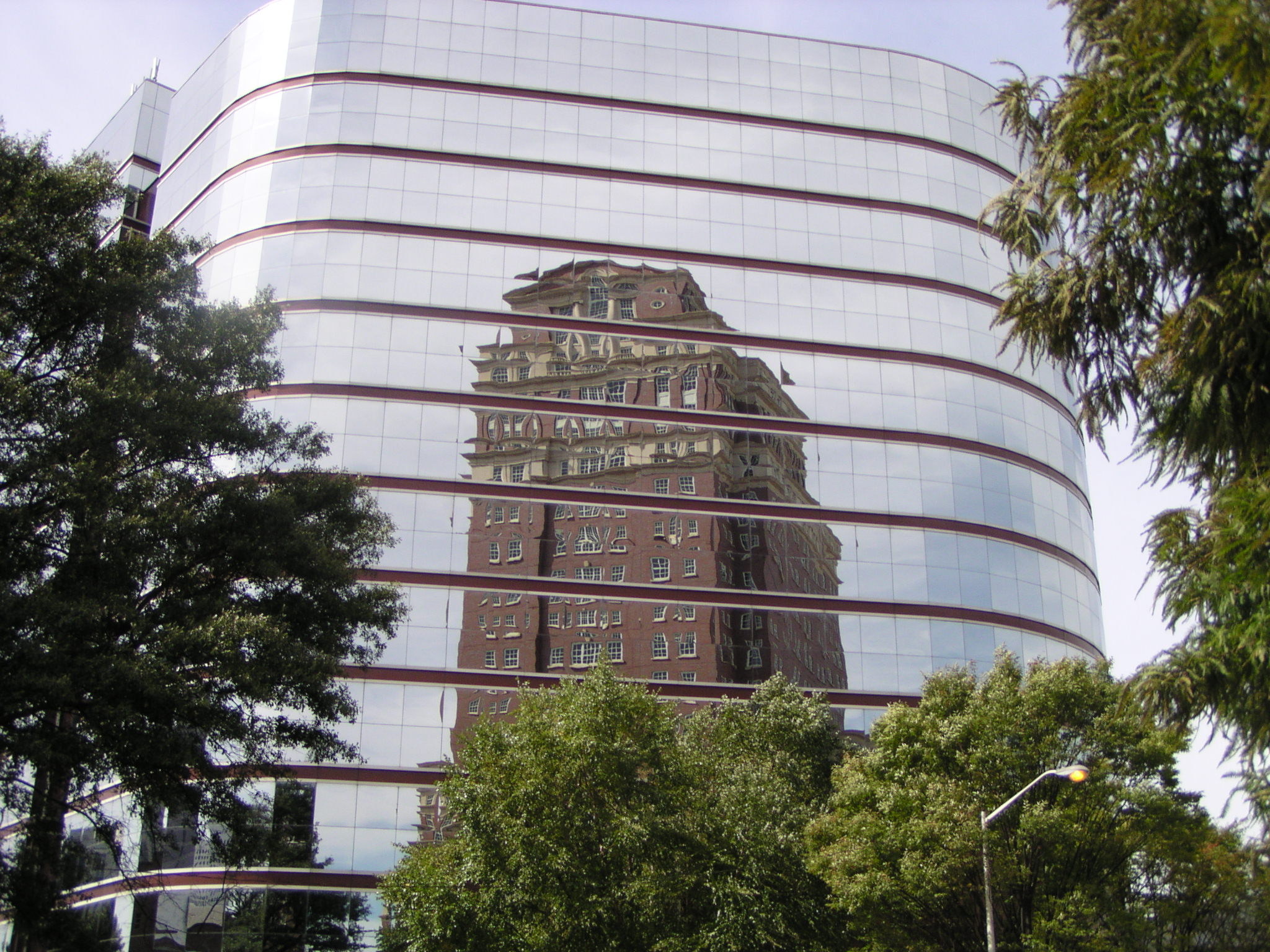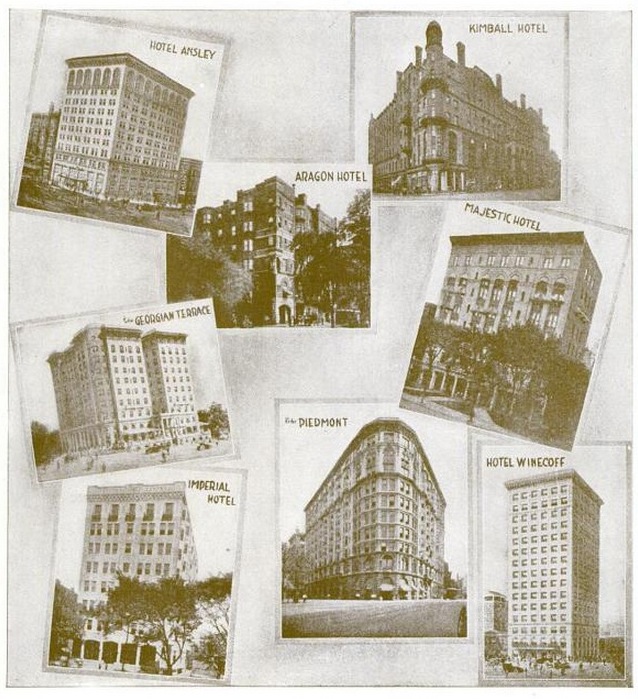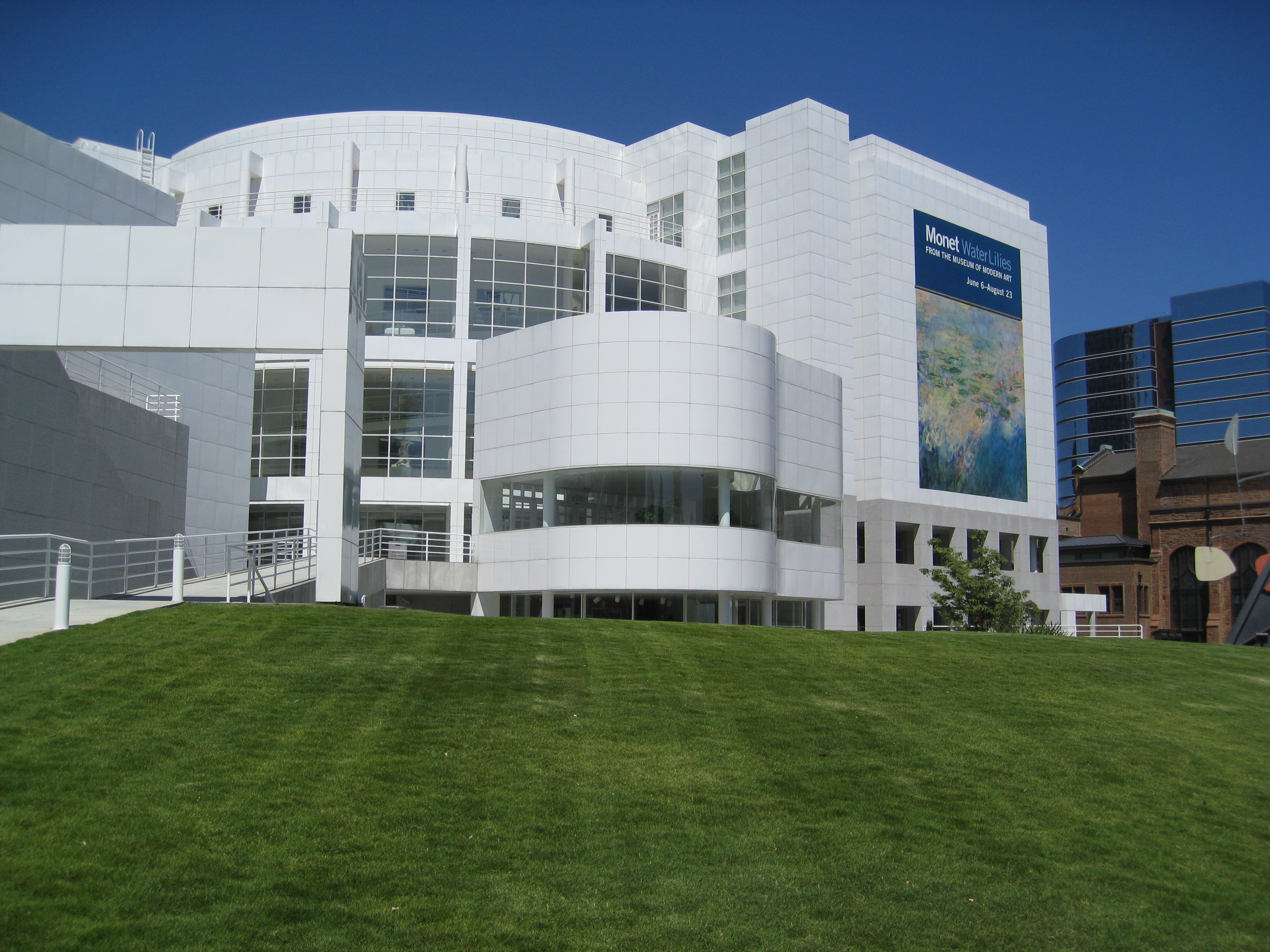Architecture of Atlanta on:
[Wikipedia]
[Google]
[Amazon]

 The architecture of Atlanta is marked by a confluence of classical, modernist, post-modernist, and contemporary architectural styles. Due to the complete destruction of Atlanta by fire in 1864, the city's architecture retains no traces of its Antebellum past. Instead, Atlanta's status as a largely post-modern American city is reflected in its architecture, as the city has often been the earliest, if not the first, to showcase new architectural concepts. However, Atlanta's embrace of modernism has translated into an ambivalence toward architectural preservation, resulting in the destruction of architectural masterpieces, including the Commercial-style Equitable Building (Atlanta's first skyscraper), the Beaux-Arts style Terminal Station, and the Classical Carnegie Library. The city's cultural icon, the Neo-Moorish Fox Theatre, would have met the same fate had it not been for a grassroots effort to save it in the mid-1970s.
The architecture of Atlanta is marked by a confluence of classical, modernist, post-modernist, and contemporary architectural styles. Due to the complete destruction of Atlanta by fire in 1864, the city's architecture retains no traces of its Antebellum past. Instead, Atlanta's status as a largely post-modern American city is reflected in its architecture, as the city has often been the earliest, if not the first, to showcase new architectural concepts. However, Atlanta's embrace of modernism has translated into an ambivalence toward architectural preservation, resulting in the destruction of architectural masterpieces, including the Commercial-style Equitable Building (Atlanta's first skyscraper), the Beaux-Arts style Terminal Station, and the Classical Carnegie Library. The city's cultural icon, the Neo-Moorish Fox Theatre, would have met the same fate had it not been for a grassroots effort to save it in the mid-1970s.

 Not a single antebellum building from what was the town of Atlanta remains today. Remaining antebellum architecture inside the city limits consists of four houses that were well outside the city limits in the 19th century, as well as the
Not a single antebellum building from what was the town of Atlanta remains today. Remaining antebellum architecture inside the city limits consists of four houses that were well outside the city limits in the 19th century, as well as the

 Most of Atlanta was burned during the Civil War, depleting the city of a large stock of its historic architecture. Yet Atlanta, architecturally, had never been particularly "southern." Because Atlanta originated as a railroad town, rather than a patrician southern seaport like
Most of Atlanta was burned during the Civil War, depleting the city of a large stock of its historic architecture. Yet Atlanta, architecturally, had never been particularly "southern." Because Atlanta originated as a railroad town, rather than a patrician southern seaport like
Big Apple
blog: * 5 October 1872, ''Appletons' Journal of Literature, Science and Art'', pg. 376: "Marvellous tales are told of this antique period in the history of the present "New York of the South," concerning acres upon acres of land, near the heart of the city, selling for fifty cents per acre, but which now are worth a snug little fortune. Such was Atlanta less than three decades ago." * 17 June 1879, ''Daily Constitution'' (Atlanta, GA), pg. 4: "...the future New York of the south - as it was predicted at the opening of the Port Royal railroad in 1873." * 6 July 1881, ''New York Times'', pg. 4: "The New-Orleans Democrat says that that city is the New-York of the South, and yet has no public library." * 29 January 1884, ''Atlanta Constitution'', pg. 4: "The New York of the South. From the New York Tribune: THE ATLANTA CONSTITUTION draws a sad picture of its environment. "Within one hundred yards of the officer," is its plaintive mean, "wagons are literally up to the hub in mud. Part of Ellis street, in a quarter mile of the depot, is literally impassable." Assuming that our contemporary's account of these wagons and this streets is literally correct, it looks as if Atlanta was likely to be known as the New York of the south." * 12 November 1891, ''Atlanta Constitution'', pg. 4: "Atlanta is a grand city. It is the New York of the south, and henceforth it can get the finest attractions produced, for its patronage is sufficient to make the very best and most expensive show a financial success." *21 October 1892, ''Atlanta Constitution'', pg. 5: "Work will cease altogether and the New York of the south will pay honor to the brave navigator, who in spite of the hardships he had to endure, pointed out a new land to the ignorant people of the time." * 19 January 1895, ''Atlanta Constitution'', pg. 4: "Cedartown Standard: Atlanta aspires to be the New York of the south - in fact, she is, and so it is perfectly natural that she should follow New York in having the big police scandal and investigation that is now on hand Throughout the American Renaissance and beyond, Atlantans were amazed at successive waves of ever more impressive hotels, civic and industrial architecture, and office buildings, such as the Equitable Building (8 stories, 1892), Candler Building (17 stories, 1906), and Rhodes-Haverty Building (21 stories, 1929). Among the most notable architects active in Atlanta between the Civil War and World War Two were
 During the Cold War era, Atlanta followed global modernist trends, especially with regards to office towers and commercial buildings. Examples of modernist architecture include the Westin Peachtree Plaza (1976), Georgia-Pacific Tower (1982), the
During the Cold War era, Atlanta followed global modernist trends, especially with regards to office towers and commercial buildings. Examples of modernist architecture include the Westin Peachtree Plaza (1976), Georgia-Pacific Tower (1982), the
 In the latter half of the 1980s, Atlanta became one of the early-adopters of postmodern designs which reintroduced classical elements to the cityscape. Many of Atlanta's tallest skyscrapers were built from the late 1980s to the early 1990s, with most displaying tapering spires or otherwise ornamented crowns, such as One Atlantic Center (1987),
In the latter half of the 1980s, Atlanta became one of the early-adopters of postmodern designs which reintroduced classical elements to the cityscape. Many of Atlanta's tallest skyscrapers were built from the late 1980s to the early 1990s, with most displaying tapering spires or otherwise ornamented crowns, such as One Atlantic Center (1987),
 With the dawn of the twenty-first century, many former industrial buildings were repurposed for residential and retail use, many along the BeltLine, former railroad rights-of-way which became a ring of trails around the central city. Examples are Ponce City Market,
With the dawn of the twenty-first century, many former industrial buildings were repurposed for residential and retail use, many along the BeltLine, former railroad rights-of-way which became a ring of trails around the central city. Examples are Ponce City Market,
Flatiron Building history

 Atlanta is home to the award-winning, internationally acclaimed Mack Scogin Merrill Elam Architects (formerly Scogin, Elam and Bray Architects). Contemporary practices include BLDGS, Lightroom, Dencity, G+G Architects, Houser Walker Architecture, plexus r+d, Smith Dalia, Square Feet Studio, and Robert M. Cain, Architect. Large firms include Stevens & Wilkinson,
Atlanta is home to the award-winning, internationally acclaimed Mack Scogin Merrill Elam Architects (formerly Scogin, Elam and Bray Architects). Contemporary practices include BLDGS, Lightroom, Dencity, G+G Architects, Houser Walker Architecture, plexus r+d, Smith Dalia, Square Feet Studio, and Robert M. Cain, Architect. Large firms include Stevens & Wilkinson,

 The architecture of Atlanta is marked by a confluence of classical, modernist, post-modernist, and contemporary architectural styles. Due to the complete destruction of Atlanta by fire in 1864, the city's architecture retains no traces of its Antebellum past. Instead, Atlanta's status as a largely post-modern American city is reflected in its architecture, as the city has often been the earliest, if not the first, to showcase new architectural concepts. However, Atlanta's embrace of modernism has translated into an ambivalence toward architectural preservation, resulting in the destruction of architectural masterpieces, including the Commercial-style Equitable Building (Atlanta's first skyscraper), the Beaux-Arts style Terminal Station, and the Classical Carnegie Library. The city's cultural icon, the Neo-Moorish Fox Theatre, would have met the same fate had it not been for a grassroots effort to save it in the mid-1970s.
The architecture of Atlanta is marked by a confluence of classical, modernist, post-modernist, and contemporary architectural styles. Due to the complete destruction of Atlanta by fire in 1864, the city's architecture retains no traces of its Antebellum past. Instead, Atlanta's status as a largely post-modern American city is reflected in its architecture, as the city has often been the earliest, if not the first, to showcase new architectural concepts. However, Atlanta's embrace of modernism has translated into an ambivalence toward architectural preservation, resulting in the destruction of architectural masterpieces, including the Commercial-style Equitable Building (Atlanta's first skyscraper), the Beaux-Arts style Terminal Station, and the Classical Carnegie Library. The city's cultural icon, the Neo-Moorish Fox Theatre, would have met the same fate had it not been for a grassroots effort to save it in the mid-1970s.
History

Antebellum
Because Atlanta was a settlement that grew from a planned railroad terminus and later a railroad junction, rather than being planned in a grand manner, its antebellum architecture was unremarkable compared to patricianSavannah
A savanna or savannah is a mixed woodland-grassland (i.e. grassy woodland) ecosystem characterised by the trees being sufficiently widely spaced so that the Canopy (forest), canopy does not close. The open canopy allows sufficient light to rea ...
or other older Southern cities. The town's most important buildings included Edward A. Vincent
Edward Arista Vincent (c. 1825 – November 27, 1856) was an architect, cartographer, and civil engineer, known for his design for Atlanta's antebellum railroad depot Union Station – destroyed by the Union Army during the Battle of Atlanta ...
's Union Station (1853), the Atlanta, Trout House
The Trout House was one of three hotels in antebellum Atlanta, Georgia, along with the Atlanta Hotel and Washington Hall. It was built in 1849 by Jeremiah F. Trout. It was a four-story brick building at the southwest corner of Decatur and Pryo ...
and Washington Hall hotels, and the Atlanta Bank. An 1859 industrial journal noted that:
19 commodious brick stores were erected in 1858…besides a large number of fine residences, mostly of brick. Many of the new improvements are imposing structures, and would not suffer by comparison with the most elegant portions of our modern cities.
Tullie Smith House
Smith Farm is a small plantation or farm house, built by Robert and Elizabeth Smith. It is Atlanta's oldest surviving farm house. It is a typical kind of plantation house owned by small farmers. The house was located in Dekalb County, Georgia ...
which was moved to the Atlanta History Center from a location in North Druid Hills, an adjacent suburb. The oldest building in Downtown Atlanta is the Georgia Railroad Freight Depot (1869).
Postbellum

 Most of Atlanta was burned during the Civil War, depleting the city of a large stock of its historic architecture. Yet Atlanta, architecturally, had never been particularly "southern." Because Atlanta originated as a railroad town, rather than a patrician southern seaport like
Most of Atlanta was burned during the Civil War, depleting the city of a large stock of its historic architecture. Yet Atlanta, architecturally, had never been particularly "southern." Because Atlanta originated as a railroad town, rather than a patrician southern seaport like Savannah
A savanna or savannah is a mixed woodland-grassland (i.e. grassy woodland) ecosystem characterised by the trees being sufficiently widely spaced so that the Canopy (forest), canopy does not close. The open canopy allows sufficient light to rea ...
or Charleston
Charleston most commonly refers to:
* Charleston, South Carolina
* Charleston, West Virginia, the state capital
* Charleston (dance)
Charleston may also refer to:
Places Australia
* Charleston, South Australia
Canada
* Charleston, Newfoundlan ...
, many of the city's landmarks could have easily been erected in the Northeast or Midwest
The Midwestern United States, also referred to as the Midwest or the American Midwest, is one of four Census Bureau Region, census regions of the United States Census Bureau (also known as "Region 2"). It occupies the northern central part of ...
, and indeed this was one reason why Atlanta referred to itself frequently as "the New York" or "the Chicago of the South."Sources documented on Barry Popik'Big Apple
blog: * 5 October 1872, ''Appletons' Journal of Literature, Science and Art'', pg. 376: "Marvellous tales are told of this antique period in the history of the present "New York of the South," concerning acres upon acres of land, near the heart of the city, selling for fifty cents per acre, but which now are worth a snug little fortune. Such was Atlanta less than three decades ago." * 17 June 1879, ''Daily Constitution'' (Atlanta, GA), pg. 4: "...the future New York of the south - as it was predicted at the opening of the Port Royal railroad in 1873." * 6 July 1881, ''New York Times'', pg. 4: "The New-Orleans Democrat says that that city is the New-York of the South, and yet has no public library." * 29 January 1884, ''Atlanta Constitution'', pg. 4: "The New York of the South. From the New York Tribune: THE ATLANTA CONSTITUTION draws a sad picture of its environment. "Within one hundred yards of the officer," is its plaintive mean, "wagons are literally up to the hub in mud. Part of Ellis street, in a quarter mile of the depot, is literally impassable." Assuming that our contemporary's account of these wagons and this streets is literally correct, it looks as if Atlanta was likely to be known as the New York of the south." * 12 November 1891, ''Atlanta Constitution'', pg. 4: "Atlanta is a grand city. It is the New York of the south, and henceforth it can get the finest attractions produced, for its patronage is sufficient to make the very best and most expensive show a financial success." *21 October 1892, ''Atlanta Constitution'', pg. 5: "Work will cease altogether and the New York of the south will pay honor to the brave navigator, who in spite of the hardships he had to endure, pointed out a new land to the ignorant people of the time." * 19 January 1895, ''Atlanta Constitution'', pg. 4: "Cedartown Standard: Atlanta aspires to be the New York of the south - in fact, she is, and so it is perfectly natural that she should follow New York in having the big police scandal and investigation that is now on hand Throughout the American Renaissance and beyond, Atlantans were amazed at successive waves of ever more impressive hotels, civic and industrial architecture, and office buildings, such as the Equitable Building (8 stories, 1892), Candler Building (17 stories, 1906), and Rhodes-Haverty Building (21 stories, 1929). Among the most notable architects active in Atlanta between the Civil War and World War Two were
A. Ten Eyck Brown
Albert Anthony Ten Eyck Brown (1878–1940) was an architect active in Atlanta, Georgia and other areas. Brown was born in Albany, New York. He studied at the New York Academy of Design.
Several of his works are listed on the U.S. National Regi ...
, Francis Palmer Smith
Francis Palmer Smith (March 27, 1886, in Cincinnati, Ohio – March 5, 1971, in Atlanta, Georgia) was an architect active in Atlanta and elsewhere in the Southeastern United States. He was the director of the Georgia Tech College of Architec ...
and G. Lloyd Preacher
Geoffrey Lloyd Preacher (May 11, 1882 – June 17, 1972) was an American architect. Based in Atlanta, Preacher and his firm specialized mostly in commercial offices, hotels, and apartment buildings in the Southeastern United States.
History ...
.
Cold War Era
 During the Cold War era, Atlanta followed global modernist trends, especially with regards to office towers and commercial buildings. Examples of modernist architecture include the Westin Peachtree Plaza (1976), Georgia-Pacific Tower (1982), the
During the Cold War era, Atlanta followed global modernist trends, especially with regards to office towers and commercial buildings. Examples of modernist architecture include the Westin Peachtree Plaza (1976), Georgia-Pacific Tower (1982), the State of Georgia Building
The State of Georgia Building (also known as 2 Peachtree Street and previously known as the First National Bank Building) is a 44-story, skyscraper located in downtown Atlanta, Georgia, U.S. Built in 1966, the building was the tallest building ...
(1966), and the Atlanta Marriott Marquis (1985).
The era's most notable architect may be Atlanta-native John Portman, whose Hyatt Regency Hotel (1968) made a significant mark on the hospitality sector. A graduate of Georgia Tech's College of Architecture, Portman's work reshaped downtown Atlanta with his designs for the Atlanta Merchandise Mart, Peachtree Center, the Westin Peachtree Plaza Hotel, and SunTrust Plaza.
Contemporary Era
 In the latter half of the 1980s, Atlanta became one of the early-adopters of postmodern designs which reintroduced classical elements to the cityscape. Many of Atlanta's tallest skyscrapers were built from the late 1980s to the early 1990s, with most displaying tapering spires or otherwise ornamented crowns, such as One Atlantic Center (1987),
In the latter half of the 1980s, Atlanta became one of the early-adopters of postmodern designs which reintroduced classical elements to the cityscape. Many of Atlanta's tallest skyscrapers were built from the late 1980s to the early 1990s, with most displaying tapering spires or otherwise ornamented crowns, such as One Atlantic Center (1987), 191 Peachtree Tower
One Ninety One Peachtree Tower is a 50-story skyscraper in Atlanta, Georgia. Designed by Johnson/Burgee Architects and Kendall/Heaton Associates Inc, the building was completed in 1990 and is the fourth tallest in the city, winning the BOMA ...
(1991), and the Four Seasons Hotel Atlanta
Four Seasons Hotel Atlanta is a hotel in Atlanta, Georgia, United States. It is part of Toronto-based Four Seasons Hotels and Resorts. The hotel is located in the Midtown Atlanta, and occupies the lower third of the GLG Grand building.
Histo ...
(1992). And at , Atlanta's tallest skyscraper—the Bank of America Plaza (1992)—is the 61st-tallest building in the world and the 9th tallest building in the United States.
More recently, Atlanta's built environment has been getting more eclectic and diverse. For example, 3344 Peachtree
3344 Peachtree is a 50-story high-rise building of height located in Atlanta's uptown business district of Buckhead on Peachtree Road, the northern extension of Peachtree Street. The building is a mixed-use tower that incorporates upscale dini ...
(2008) is more in the glass-walled modernist vein, while Millennium Gate (also completed in 2008) is the largest classical monument in the U.S. to have been dedicated since completion of the Jefferson Memorial in Washington, D.C.
Repurposed industrial architecture
 With the dawn of the twenty-first century, many former industrial buildings were repurposed for residential and retail use, many along the BeltLine, former railroad rights-of-way which became a ring of trails around the central city. Examples are Ponce City Market,
With the dawn of the twenty-first century, many former industrial buildings were repurposed for residential and retail use, many along the BeltLine, former railroad rights-of-way which became a ring of trails around the central city. Examples are Ponce City Market, Krog Street Market
Krog Street Market is a mixed-use development in Atlanta, located along the BeltLine trail at Edgewood Avenue in Inman Park which opened in Summer 2014. The complex is centered on a , west coast-style market and restaurants, and also includes up ...
, Telephone Factory Lofts
The Telephone Factory Lofts is a mixed-use loft building along the BeltLine trail in the Poncey-Highland neighborhood of Atlanta. It is listed on the National Register of Historic Places as the Western Electric Company Building.
Layout
The main ...
, Fulton Bag and Cotton Mills, King Plow and Goat Farm Arts Centers and many others, particularly in the Old Fourth Ward
The Old Fourth Ward, often abbreviated O4W, is an intown neighborhood on the eastside of Atlanta, Georgia, United States. The neighborhood is best known as the location of the Martin Luther King Jr. historic site.
Geography
The Old Fourth Wa ...
, Inman Park Village, Cabbagetown and Reynoldstown, and the Marietta Street Artery.
Notable Architecture
Arts facilities have led the way for modernists in Atlanta architecture with the High Museum designed byRichard Meier
Richard Meier (born October 12, 1934) is an American abstract artist and architect, whose geometric designs make prominent use of the color white. A winner of the Pritzker Architecture Prize in 1984, Meier has designed several iconic buildings ...
with a 2005 addition by Renzo Piano. A recent design competition resulted in Freelon Associates (in conjunction with HOK) being selected as the architect for the new $100 million home of the Center for Civil and Human Rights. Michael Graves' post-modern style is exhibited in the Ten Peachtree Place office building in Midtown and the Michael C. Carlos Museum on the campus of Emory University. The 50-story One Atlantic Center was designed by Philip Johnson in association with John Burgee. Completed in 1980, the Atlanta-Fulton Central Public Library was designed by one of the 20th century's most notable modernists architects, Marcel Breuer, who holds the distinction of having studied and taught at the Bauhaus, where early in his career Breuer first became a renowned furniture designer. Atlanta also has its own Flatiron Building, built in 1897, five years before the more famous Flatiron Building in New York City (1902).Skyscrapers
Firms, Universities, and Organizations

 Atlanta is home to the award-winning, internationally acclaimed Mack Scogin Merrill Elam Architects (formerly Scogin, Elam and Bray Architects). Contemporary practices include BLDGS, Lightroom, Dencity, G+G Architects, Houser Walker Architecture, plexus r+d, Smith Dalia, Square Feet Studio, and Robert M. Cain, Architect. Large firms include Stevens & Wilkinson,
Atlanta is home to the award-winning, internationally acclaimed Mack Scogin Merrill Elam Architects (formerly Scogin, Elam and Bray Architects). Contemporary practices include BLDGS, Lightroom, Dencity, G+G Architects, Houser Walker Architecture, plexus r+d, Smith Dalia, Square Feet Studio, and Robert M. Cain, Architect. Large firms include Stevens & Wilkinson, Perkins and Will
Perkins&Will is a global design practice founded in 1935. Since 1986, the group has been a subsidiary of Lebanon-based Dar Al-Handasah (Arabic: دار الهندسة). Phil Harrison has been the firm's CEO since 2006.
History
The firm was establ ...
(Owned by Dar Al-Handasah), Collins Cooper Carusi, TVS (Thompson, Ventulett, Stainback & Associates
TVS is an architecture, planning, and interior design firm in Atlanta.
History
Founded in 1968 by Bill Thompson, Tom Ventulett, and Ray Stainback, tvsdesign has designed several notable buildings in greater Atlanta and beyond throughout the yea ...
), Lord Aeck Sargent, Smallwood, Reynolds, Stewart, Stewart & Associates, and Cooper Carry
Cooper Carry is a U.S.-based design firm providing architecture, planning, landscape architecture, interior design and environmental graphic design. The company is based in Atlanta with offices in Alexandria, Virginia; New York City; and ( Newport ...
Inc.
The Georgia Institute of Technology College of Architecture, located just west of midtown Atlanta offers both pre-professional undergraduate and professional graduate degrees in architecture, and hosts regular lectures and symposia of interest to students and professionals. Kennesaw State University formerly known as Southern Polytechnic State University in Marietta, a suburb of Atlanta, offers a five-year professional undergraduate degree and also hosts lectures and exhibits works in the architecture building's gallery space.
The Young Architects Forum of the Atlanta chapter of the American Institute of Architects sponsors open design competitions, exhibits, and lectures of interest to the profession and the general public.
References
{{DEFAULTSORT:Atlanta Culture of Atlanta